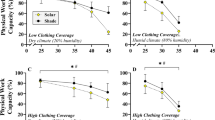Abstract
In COST Action 730, a multi-segmental thermophysiological model was used to describe physiological strain reactions for different climatic conditions in order to develop a 'Universal Thermal Climate Index' (UTCI). UTCI predictions for warm climates were compared with empirical data from the laboratory tests. The comparison was performed by means of equivalence lines within a psychrometric chart so that the combined influence of air temperature and humidity on physiological strain may be assessed. Within a reasonable regime of air temperatures and relative humidities (RH), the differences between simulated and measured values were as follows: for rectal temperatures below 0.3°C, for skin temperatures below 1.5°C, for sweat rates below 200 g/h and for heart rates (estimated from relative cardiac output) below 30 min−1. This characterises the validity of the model with respect to the description of the influence of heat and humidity on physiological strain. The same comparison to physiological data was also conducted for the equivalent temperature calculated for UTCI. In order to compare UTCI with other thermal indices used in occupational health, the physiological data have also been compared to equivalence lines of WBGT (Wet Bulb Globe Temperature) and PHS (Predicted Heat Strain) indices.







Similar content being viewed by others
References
Bröde P, Schütte M, Kampmann B, Griefahn B (2009) Heat acclimation and its relation to resting core temperature and heart rate. Occup Ergon 8:185–193. doi:10.3233/OER-2009-0168
Bröde P, Fiala D, Blazejczyk K, Holmér I, Jendritzky G, Kampmann B, Tinz B, Havenith G (2011) Deriving the operational procedure for the Universal Thermal Climate Index UTCI. Int J Biometeorol: in this special issue
Cleveland WS, Loader CL (1996) Smoothing by local regression: principles and methods. In: Härdle W, Schimek MG (eds) Statistical theory and computational aspects of smoothing. Springer, New York, pp 10-49 http://www.stat.purdue.edu/~wsc/papers/localregression.principles.ps, accessed 2008-10-12
Fiala D, Havenith G, Bröde P, Kampmann B, Jendritzky G (2011) UTCI-Fiala multi-node model of human temperature regulation and thermal comfort. Int J Biometeorol: in this special issue
Houghten FC, Yagloglou CP (1923) Determining lines of equal comfort. Trans Am Soc Heat Ventil Eng 29:163–176
Ilmarinen R (1978) Einflüsse verschiedener Bekleidung auf einige physiologische Größen des Menschen bei Körperarbeit in unterschiedlich erhöhter Umgebungstemperatur und Luftfeuchtigkeit. Thesis, Deutsche Sporthochschule Köln
ISO 7243 (1989) Hot environments; estimation of the heat stress on working man, based on the WBGT-index (wet bulb globe temperature). International Organisation for Standardisation, Geneva
ISO 7933 (2004) Ergonomics of the thermal environment - Analytical determination and interpretation of heat stress using calculation of the predicted heat strain. International Organisation for Standardisation, Geneva
Havenith G, Fiala D, Blazejczyk K, Richards M, Bröde P, Holmér I, Rintamäki H, Benshabat Y, Jendritzky G (2011) The UTCI-Clothing Model. Int J Biometeorol: in this special issue
Kampmann B (2000) Zur Physiologie der Arbeit in warmem Klima. Ergebnisse aus Laboruntersuchungen und aus Feldstudien im Steinkohlenbergbau. Habilitationsschrift zur Erlangung der Venia Legendi im Fach Arbeitsphysiologie des Fachbereiches Sicherheitstechnik an der Bergischen Universität – Gesamthochschule Wuppertal http://elpub.bib.uni-wuppertal.de/edocs/dokumente/fb14/habi2000/kampmann
Kampmann B, Bröde P, Havenith G, Jendritzky G (2008) Der Entwicklungsstand des klimatischen Belastungs-Index UTCI (Universal Thermal Climate Index). In: Gesellschaft für Arbeitswissenschaft (ed), Produkt- und Produktions-Ergonomie - Aufgabe für Entwickler und Planer, 54. Kongress der Gesellschaft für Arbeitswissenschaft. GfA-Press, Dortmund, pp 243-246
Malchaire J, Piette A, Kampmann B, Mehnert P, Gebhardt H, Havenith G, den Hartog EA, Holmér I, Parsons K, Alfano G, Griefahn B (2001) Development and validation of the predicted heat strain model. Ann Occup Hyg 45:123–135
Psikuta A, Fiala D, Laschewski G, Jendritzky G, Richards M, Blazejczyk K, Mekjavic I, Rintamäki H, Havenith G, de Dear R (2011) Evaluation of the Fiala multi-node thermophysiological model for UTCI application. Int J Biometeorol: in this special issue
Wenzel HG (1976) Physiologically equivalent combinations of elevated environmental temperature and air humidity. In: Hemp E, Lancaster FH (eds): Proc. Int. Mine Ventil. Congr., Johannesburg 1975. The Mine Ventilation Society of South Africa, Johannesburg, pp 255–259
Acknowledgement
This work was funded as European Union COST Action 730 “Towards a Universal Thermal Climate Index UTCI for Assessing the Thermal Environment of the Human Being”. COST is supported by the EU RTD Framework Programme.
Author information
Authors and Affiliations
Corresponding author
Electronic supplementary material
Below is the link to the electronic supplementary material.
MOESM 1
Bernhard Kampmann, Peter Bröde, Dusan Fiala: Physiological responses to temperature and humidity compared to the assessment by UTCI, WGBT and PHS (PDF 553 kb)
Rights and permissions
About this article
Cite this article
Kampmann, B., Bröde, P. & Fiala, D. Physiological responses to temperature and humidity compared to the assessment by UTCI, WGBT and PHS. Int J Biometeorol 56, 505–513 (2012). https://doi.org/10.1007/s00484-011-0410-0
Received:
Accepted:
Published:
Issue Date:
DOI: https://doi.org/10.1007/s00484-011-0410-0




